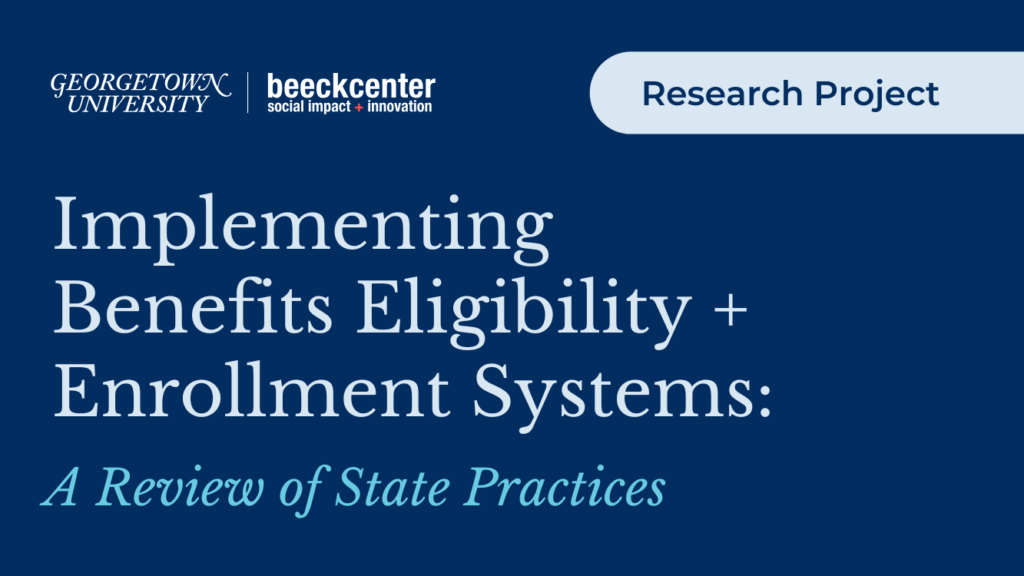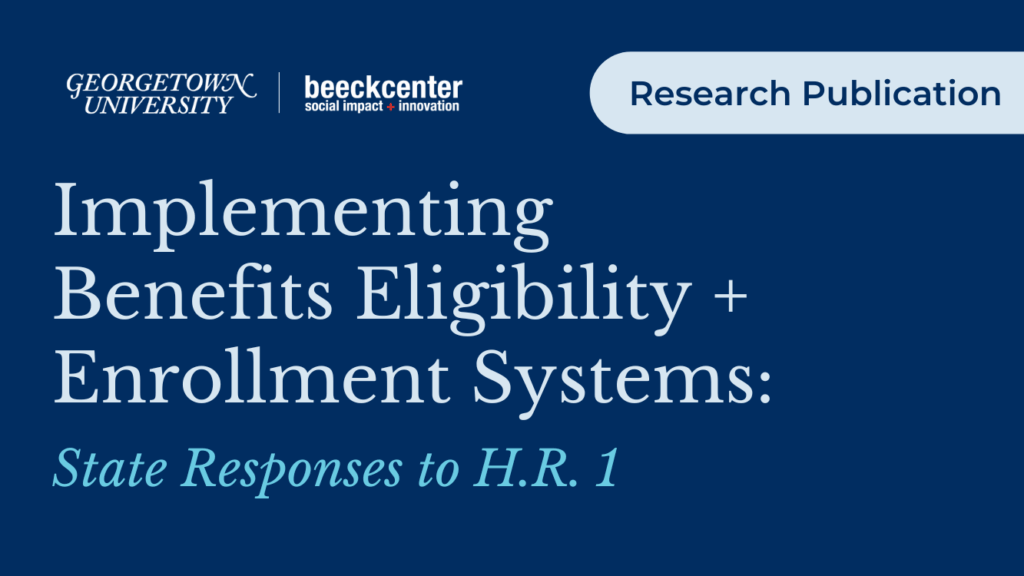Implementing Benefits Eligibility + Enrollment Systems: A Review of State Practices

How do state benefits administering agencies interpret policies and translate them into digital systems for eligibility and enrollment?
Project Background
Many U.S. states and territories operate integrated eligibility and enrollment systems (IEE), which allow people to apply for multiple public benefits programs through one process rather than having to apply through separate processes for each program. Some of these systems are an integrated application tied to multiple back end systems for enrollment and case management, while others are a unified application and back end across programs.
To effectively build these systems and deliver benefits to their constituents, state benefits administering agencies and their partner organizations must interpret and translate policies into software code. IEE systems must consider impacts to eligibility across programs and also update rules over time as policies change.
Since many people qualify for several benefits programs, it is important that IEE systems are easy to use and accurately determine someone’s eligibility. Well-designed IEE systems can also enable agencies to more efficiently enroll beneficiaries in programs by streamlining case management and beneficiary touchpoints.
This research project is an extension of the Digital Benefits Network’s research into the Rules as Code (RaC) approach to digitalizing legislation and policy documents. Since 2021, we have covered many angles of this approach:
- Explaining the RaC concept and how it might apply in the U.S. public benefits context,
- Exploring how rules are currently communicated and how they might be in the future, and
- Experimenting with how AI might help us translate between policy and code.
Research Overview
This research documents states’ current processes for building and maintaining IEE systems, including how they interpret and translate policies into code.
Throughout summer 2025, the DBN conducted interviews with leaders from seven states which operate or are building IEEs for core programs (i.e., the Supplemental Nutrition Assistance Program (SNAP), Medicaid, Temporary Assistance for Needy Families (TANF), child care, etc). The team is currently analyzing what we learned to produce a comprehensive set of insights.
Keep on eye on this page for several upcoming brief publications with insights about the following topics:
- How states are responding to recent policy changes from federal agencies and Congress, including those enacted under H.R. 1
- State processes for translating, updating, and maintaining policy and rules in IEE systems
- Technologies and software used in IEE systems
- Common challenges states face when operating and building IEE systems
- How agencies that operate IEE systems are employing new processes and emerging technologies
- Recommendations for states operating or building IEE systems
Research Methods
To answer our research questions, we conducted semi-structured interviews with state agency staff and leaders. Our research project received approval from Georgetown University’s Institutional Review Board (IRB). We conducted all of our research interviews via Zoom.
Between mid-July and mid-September 2025, we spoke to twenty four individuals from seven states in a mix of individual and group interviews. Participants were presented with written information about the research project prior to scheduling an interview, and we also obtained verbal consent during the interviews. In line with IRB requirements, we deidentified all audio recordings and transcripts and stored these files in a secure file location. To analyze our de-identified research data, we used a mix of inductive and deductive coding in Dovetail, a qualitative research platform. After data was coded, our research team conducted multiple team synthesis sessions to translate identified themes into insights, and check initial insights against data.
All publications from this project will be published without attribution.
Publications

Our first publication in this series is now live! Read how states are responding to H.R. 1 through implementing changes to their IEE systems.
Get Updates
Join the Digital Benefits Network to receive updates as the publications are released and participate in our Rules as Code Community of Practice.
Related Content
Benefit Eligibility Rules as Code: Reducing the Gap Between Policy and Service Delivery for the Safety Net
This report examines how the U.S. federal government can enhance the efficiency and equity of benefit delivery by simplifying eligibility rules and using a Rules as Code approach for digital systems.
Exploring Rules Communication: Moving Beyond Static Documents to Standardized Code for U.S. Public Benefits Programs
This brief analyzes the current state of federal and state government communication around benefits eligibility rules and policy and how these documents are being tracked and adapted into code by external organizations.
AI-Powered Rules as Code: Experiments with Public Benefits Policy
This report documents four experiments exploring if AI can be used to expedite the translation of SNAP and Medicaid policies into software code for implementation in public benefits eligibility and enrollment systems under a Rules as Code approach.